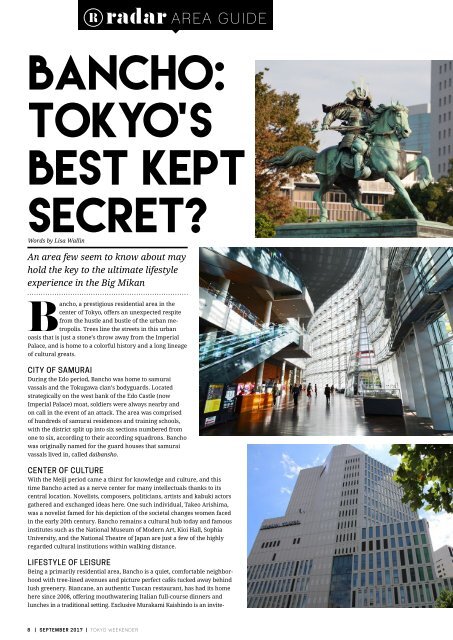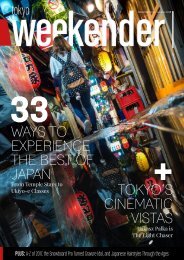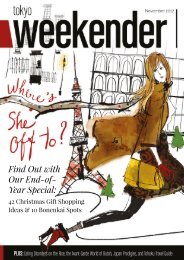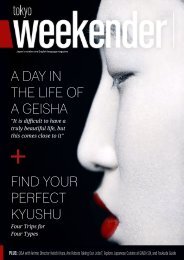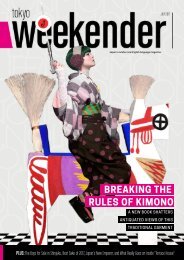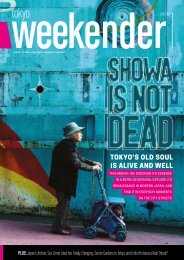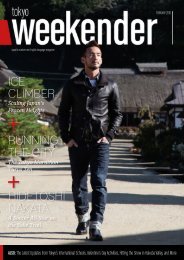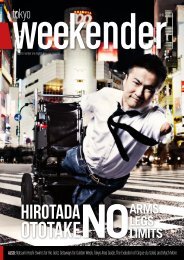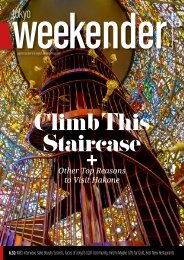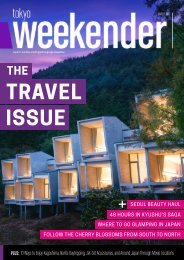Tokyo Weekender - September 2017
Autumn eyes: Harajuku lashes and more tips from a/w17. GACKT: "There's an emptiness in people's hearts". Find your "ikigai": What makes you get up in the morning? Plus: "Life in transit" photo story, osaka on two wheels, the tokyo café serving prophecies, and ufc's big comeback.
Autumn eyes: Harajuku lashes and more tips from a/w17.
GACKT: "There's an emptiness in people's hearts".
Find your "ikigai": What makes you get up in the morning?
Plus: "Life in transit" photo story, osaka on two wheels, the tokyo café serving prophecies, and ufc's big comeback.
Create successful ePaper yourself
Turn your PDF publications into a flip-book with our unique Google optimized e-Paper software.
AREA GUIDE<br />
BANCHO:<br />
TOKYO’S<br />
BEST KEPT<br />
SECRET?<br />
Words by Lisa Wallin<br />
An area few seem to know about may<br />
hold the key to the ultimate lifestyle<br />
experience in the Big Mikan<br />
Bancho, a prestigious residential area in the<br />
center of <strong>Tokyo</strong>, offers an unexpected respite<br />
from the hustle and bustle of the urban metropolis.<br />
Trees line the streets in this urban<br />
oasis that is just a stone’s throw away from the Imperial<br />
Palace, and is home to a colorful history and a long lineage<br />
of cultural greats.<br />
CITY OF SAMURAI<br />
During the Edo period, Bancho was home to samurai<br />
vassals and the Tokugawa clan’s bodyguards. Located<br />
strategically on the west bank of the Edo Castle (now<br />
Imperial Palace) moat, soldiers were always nearby and<br />
on call in the event of an attack. The area was comprised<br />
of hundreds of samurai residences and training schools,<br />
with the district split up into six sections numbered from<br />
one to six, according to their according squadrons. Bancho<br />
was originally named for the guard houses that samurai<br />
vassals lived in, called daibansho.<br />
CENTER OF CULTURE<br />
With the Meiji period came a thirst for knowledge and culture, and this<br />
time Bancho acted as a nerve center for many intellectuals thanks to its<br />
central location. Novelists, composers, politicians, artists and kabuki actors<br />
gathered and exchanged ideas here. One such individual, Takeo Arishima,<br />
was a novelist famed for his depiction of the societal changes women faced<br />
in the early 20th century. Bancho remains a cultural hub today and famous<br />
institutes such as the National Museum of Modern Art, Kioi Hall, Sophia<br />
University, and the National Theatre of Japan are just a few of the highly<br />
regarded cultural institutions within walking distance.<br />
LIFESTYLE OF LEISURE<br />
Being a primarily residential area, Bancho is a quiet, comfortable neighborhood<br />
with tree-lined avenues and picture perfect cafés tucked away behind<br />
lush greenery. Biancane, an authentic Tuscan restaurant, has had its home<br />
here since 2008, offering mouthwatering Italian full-course dinners and<br />
lunches in a traditional setting. Exclusive Murakami Kaishindo is an invite-<br />
8 | SEPTEMBER <strong>2017</strong> | TOKYO WEEKENDER


